Getting Started Guides: WordPress Hosting Questions
In-depth guides to help you get started with 20i WordPress Hosting
WordPress Hosting: Getting Started
You’ve just registered for one of the world’s fastest and most advanced WordPress web hosting platforms. This Getting Started Guide is designed to help you learn more about WordPress at 20i and how to build, manage and maintain your website easily.
WordPress is a content management system (CMS) with a huge range of potential uses. Although it originally started out as a blogging platform, it can be used to create anything from ecommerce stores to magazines. It has hundreds of thousands of plugins and themes so you can create a website that truly stands out from the crowd.
This WordPress Getting Started Guide will introduce our hosting features and show you how to perform all the essential tasks.
Content in this guide:
- WordPress Hosting: Introduction
- WordPress Hosting: Completing your WordPress Installation
- WordPress Hosting: Migrating an existing WordPress website to 20i
- WordPress Hosting: The My20i Control Panel
- WordPress Hosting: Managing your Hosting
- WordPress Hosting: WordPress Staging
- WordPress Hosting: Security and Backups
- WordPress Hosting: Further Help and Next Steps
This guide has been written for 20i’s WordPress Hosting services on our shared hosting platform. If you encounter an issue at any point or you’re not sure what to do next, please raise a ticket in My20i and our friendly support team will help you out.
>> Next Step: Completing your WordPress Installation
 Corey Seymour
Corey SeymourWordPress Hosting: Completing your WordPress installation
Having signed up for the best WordPress hosting in the business; you are now in a position to start adding hosting packages.
Head over to My20i where you’ll see the Hosting Management section. Press the ‘Add Package’ button under the ‘Manage Hosting’ icon.
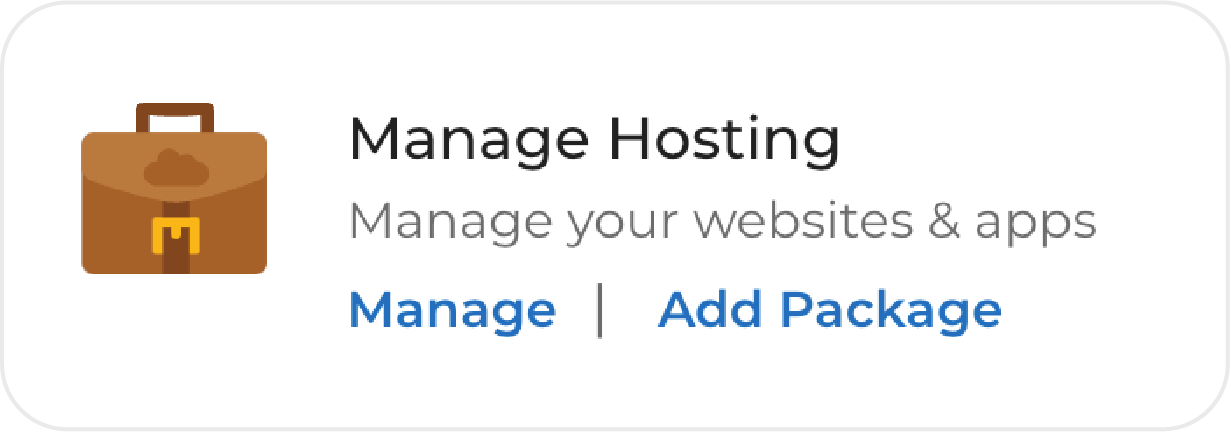
You will be presented with 4 ways to add packages. For this tutorial we will use ‘Create a New Hosting Package.’
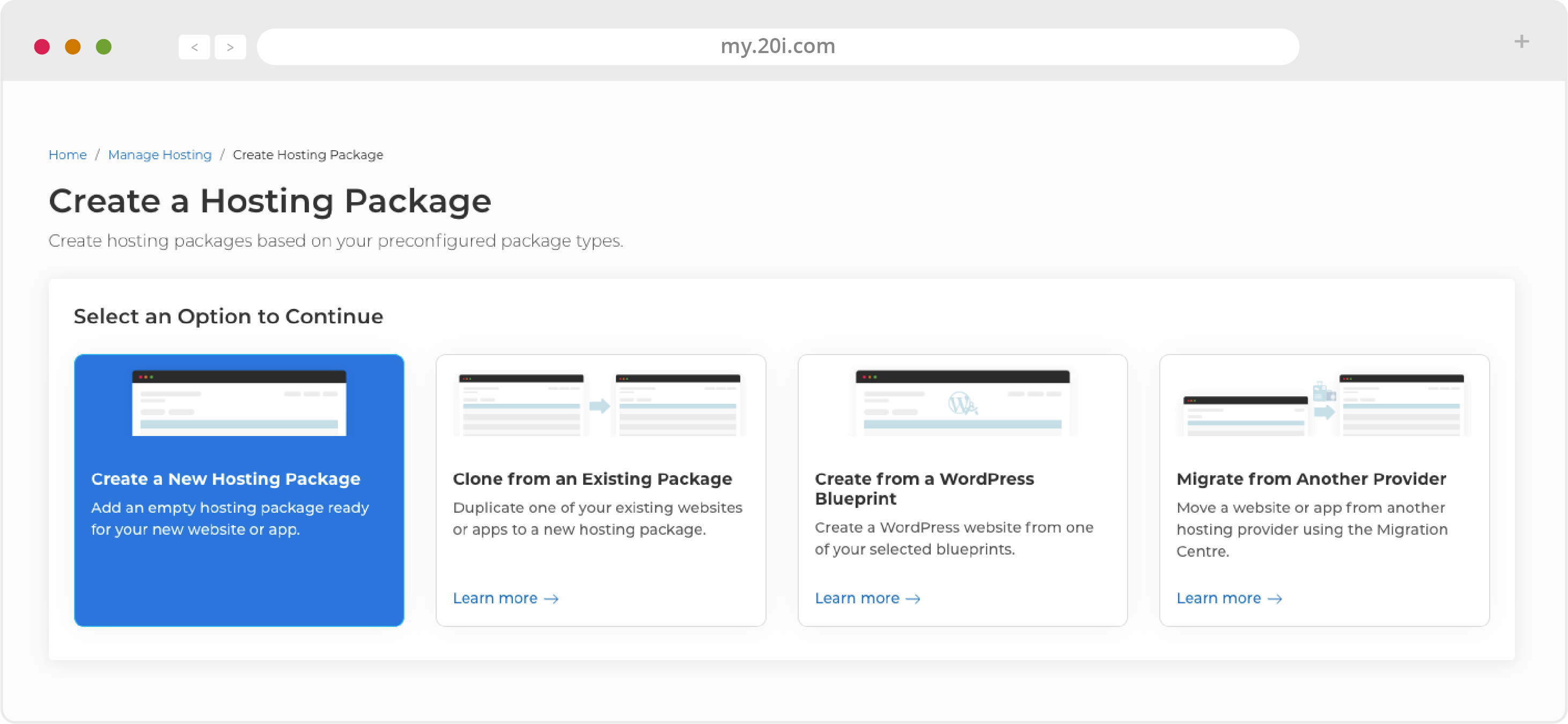
The next step is to select a domain name. If you already have a domain with us then you can use the drop down menu to select it. If not, you can type out the domain name in this box.

Choose WordPress from the available platforms.

Now select the Data Centre situated closest to your users.

If you have created or imported users, you can assign them here. When ready - click ‘Create Hosting Package’.

After a few short moments your package will be added, and you’ll be taken to the ‘Manage Hosting’ section of your My20i control panel.
From here, you will be able to see all packages you have hosted with us. Click ‘Options’ and then ‘Manage’ on the package you just added.

By default, WordPress Tools appears at the top of the dashboard. We haven’t done anything with this newly added package yet, so you’ll see an orange error message at the top of WordPress Tools notifying us that ‘WordPress is not installed’. We’ll take care of that by clicking on the ‘WordPress Install Wizard’.
The WordPress Installer will now load.
Choose your language. English (United States) is the default option. If you need English (UK) or any other language then scroll down, click it and then press ‘Continue’.
We have reached the final part of the process - entering the information that you’d like the site to use.
- Site Title - Don’t worry too much about what you put here; you can easily change your title later on from your WordPress dashboard
- Username – This is the default administrator username for your WordPress install. Never use the username ‘admin’ (or a variant of) for security reasons
- Password – A strong password is generated for you, we recommend saving that password via a password manager of your choice rather than opting for a less secure password
- Your email address – Double-check for typos as WordPress will email you with all the details you need for your new WordPress website. Your email address can be changed later on, so if you’re setting up and configuring WordPress for a client, we recommend you enter your own email address for this part
- Privacy – We suggest leaving the ‘Discourage search engines from indexing this site’ box unchecked even if you’re not going to put your site live for a while. This is because it can take a long time for search engines to find, crawl and index your site even after you adjust the setting again in WordPress later on
After you’ve filled out the fields, select the ‘Install WordPress’ button. After a few seconds you’ll see the ‘Success!’ message, and
will be able to log into your new WordPress installation using the username and password that you specified in the previous step.
Building your website
With WordPress freshly installed; you are ready to build your website. There are a couple of ways to do this on our platform.
The first is to simply log into WordPress and begin building from scratch. We specialise in providing superb hosting services; the nitty gritty of designing and building websites is outside of the scope of what we do.
If you need help or inspiration then you’ll be pleased to know that there are thousands of templates and guides available online to help you achieve your goals. Remember to apply Maintenance Mode (detailed here) if you’d like some privacy while you build.
If you have moved to us from another provider, then you may already have a WordPress website ready to go. Transferring an existing WordPress website is a simple and straightforward process that we’ll cover in the next chapter.
We also have a staging feature that lets you work a on private clone of your WordPress installation away from prying eyes. The idea of this feature is to develop, test and perfect the staged version and then essentially copy and paste it in place of your blank installation. See chapter 5 for more about WordPress Staging.
>> Next Step: Migrating an existing WordPress website to 20i
 Corey Seymour
Corey SeymourWordPress Hosting: Migrating an existing WordPress website to 20i
If your WordPress website is currently hosted with a different provider, please ensure you have an up-to-date backup of your WordPress data and database before beginning the migration process.
If you have more than 10 sites to move over, and would like some assistance; contact our support team to learn more about our Assisted Migration service.
There are three ways to migrate your existing WordPress website:
- Using our Migration Centre to migrate using FTP/SFTP
- Use a WordPress migration plugin
- Manual migration
1/ The 20i Migration Centre
This is the most convenient way to migrate. It can migrate any type of website from another host automatically, but in this example we’ll use WordPress.
Head to the Migrations Centre control bar in My20i and select 'Start Migration'

Click the ‘Start Migration’ button and choose 'Migrate a WordPress site using FTP/SFTP'
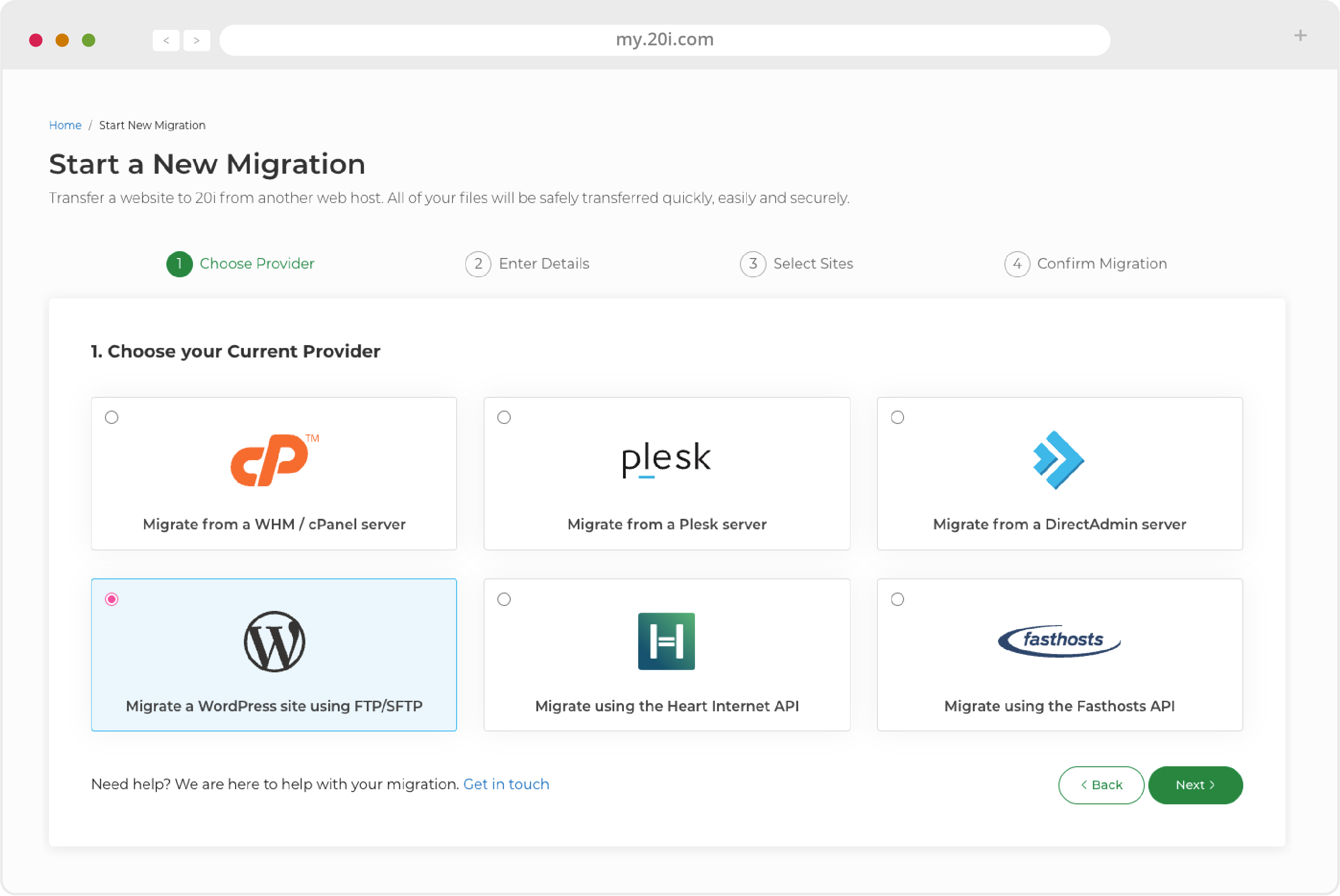
Then enter the following four pieces of information:
- Hostname: the FTP/SFTP hostname, so the server you’d connect to
- Domain: the domain name of the site you’ll be migrating
- Username: the FTP/SFTP username you’ll use, it is very often the domain of the site e.g. example.com
- Password: the password you’d use to connect to FTP/SFTP
The Migration Centre will then show the packages to be migrated. Begin the migration process by pressing ‘Start New Migration’
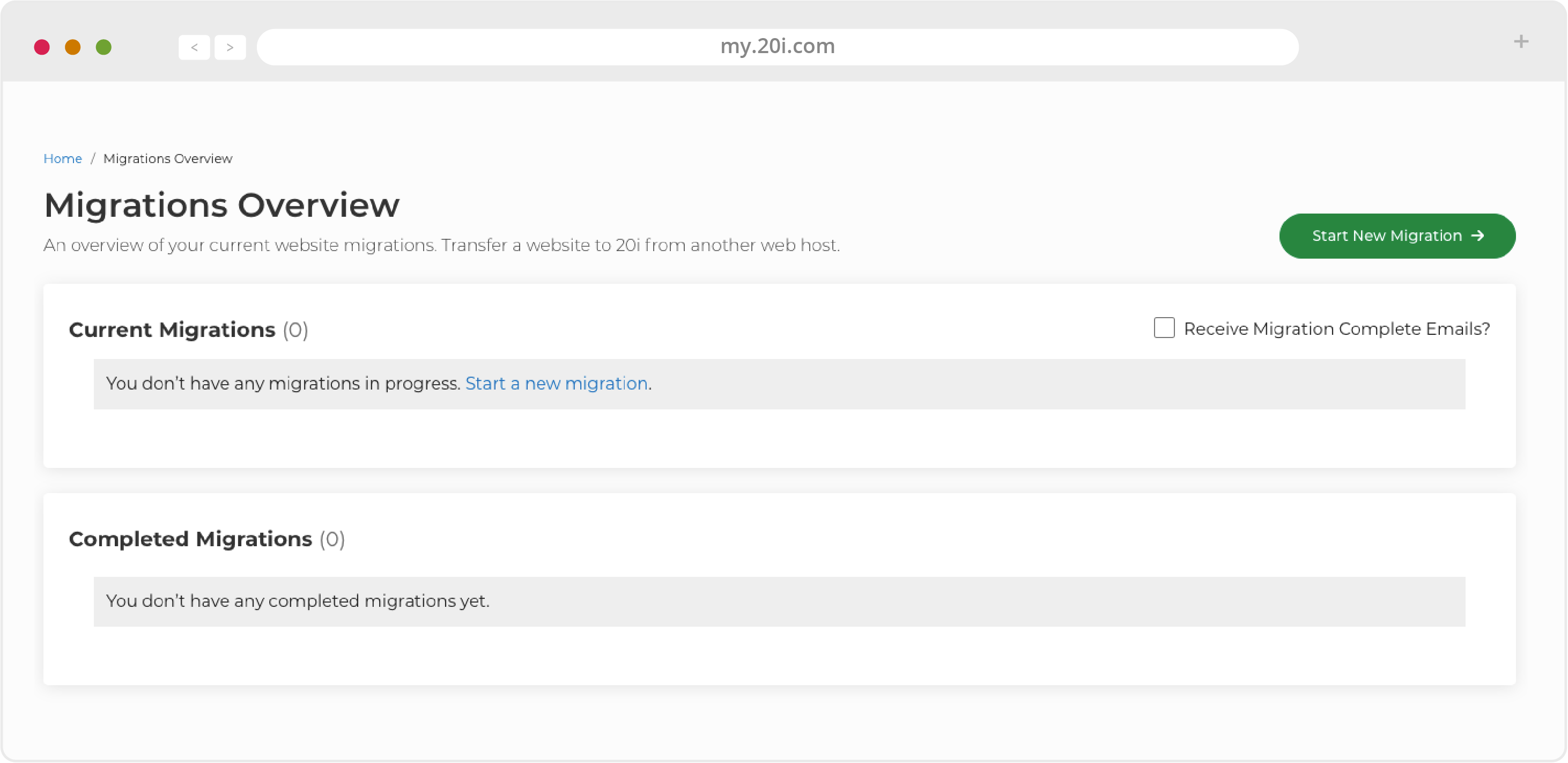
Average sized sites migrate in 30 minutes to 1 hour. By default, you’ll get an email to let you know the migration has completed.
If you don’t want these notification emails, then you can turn them off by unchecking the ‘Receive Migration Complete Emails?’ box near the top of the Migrations Overview page.
2/ Using a migration plugin
There are a variety of free migration plugins in the official WordPress plugin directory, located at https://en-gb.wordpress.org/plugins.
The majority are compatible with 20i hosting, but we recommend using All-in-One WP Migration.
Install the migration plugin by logging-in to your existing WordPress website, then choosing ‘Plugins’ > ‘Add new’
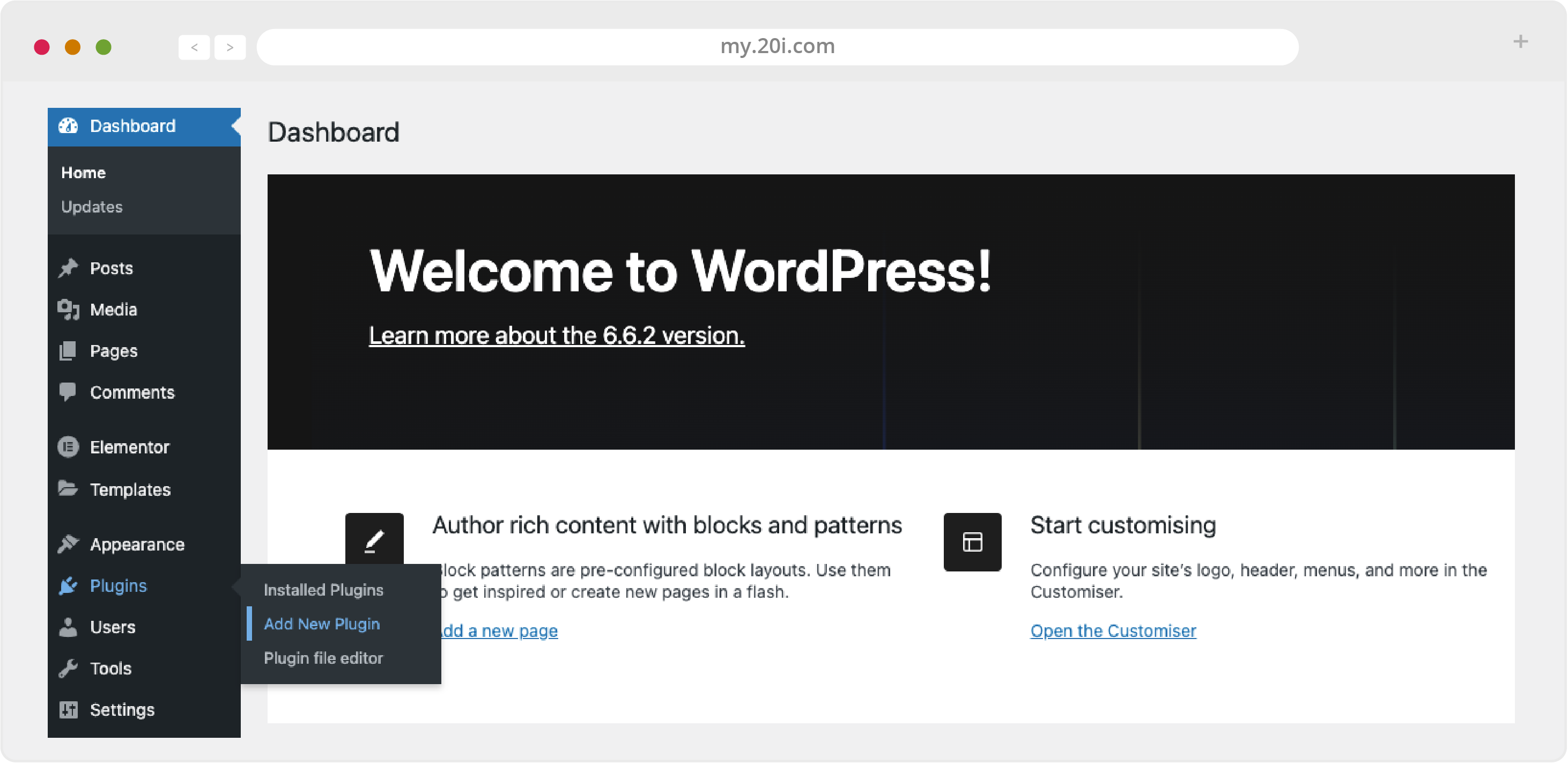
Search for the migration plugin of your choice, click ‘Install’, and then activate it on the same screen
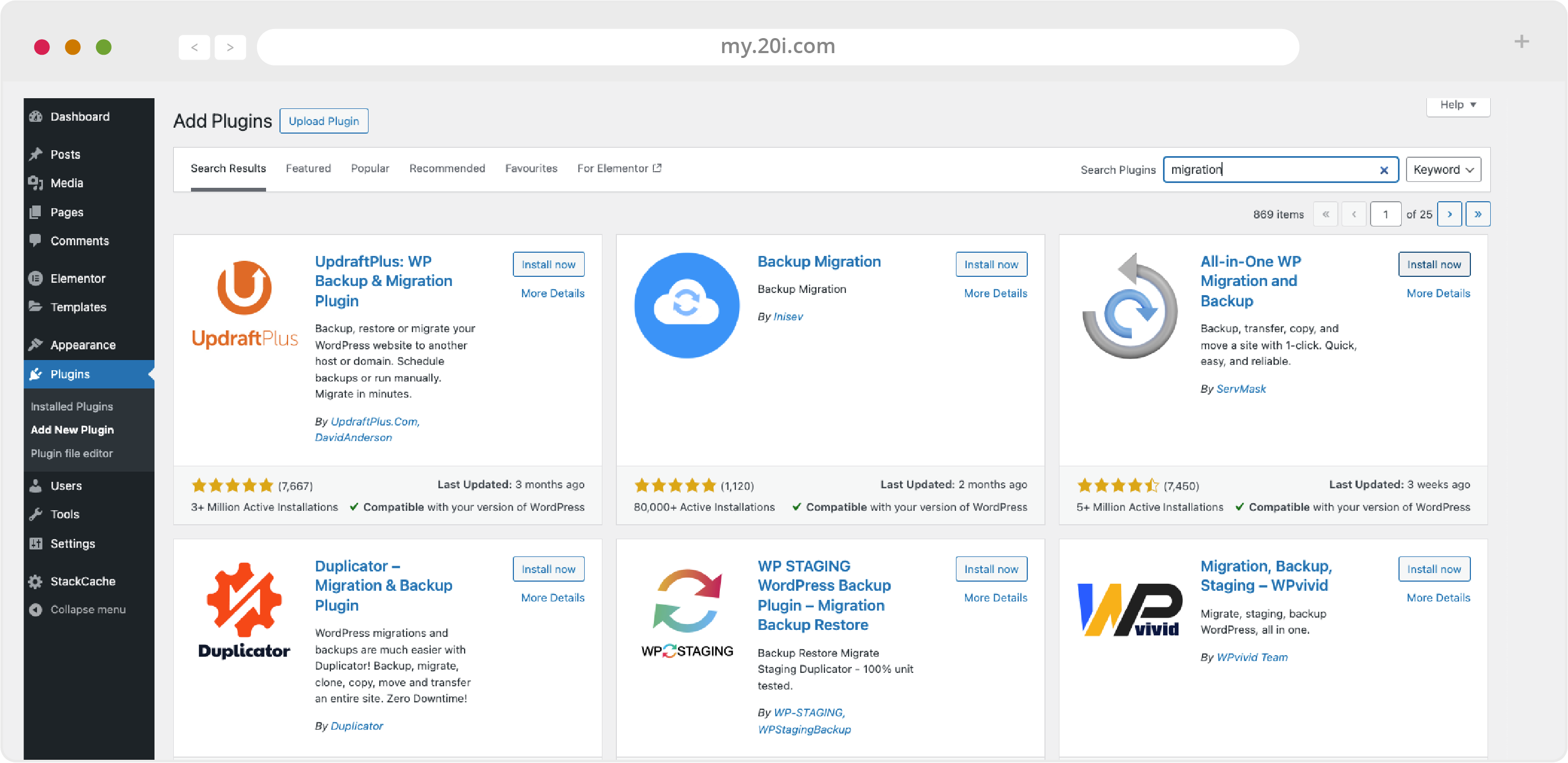
Follow the plugin creator’s guidance for site migration (this will usually involve going to ‘Tools’ and/or ‘Settings’ in your WordPress dashboard and following the instructions)
3/ Manual migration
Here's how to migrate manually:
1. Download your website’s files
Make an FTP connection using the details from your old provider, and download all files from the web space to your local computer.
2. Downloading your database
You’ll need to bring along all the databases your website is using for it to work properly. All major hosts will be running phpMyAdmin management software. Here is how to export your databases:
- Access phpMyAdmin
- Click the database you wish to backup down the left-hand side
- Click the ‘Export’ tab at the top of your page
- Leave ‘Quick’ selected under Export Method
- Select your desired format - we recommend SQL for most cases - and Select ‘Go’
3. Upload website files to 20i
Before you change nameservers or update DNS for your domain, you’ll need to transfer the website files you downloaded to your local machine in step 1.
Get the FTP hostname from the ‘Nameserver Setup’ section of your new package on My20i. This information appears when the domain of the package you are managing is not using our nameservers.
Scroll down and you’ll see the details on the right-hand side when you’re managing your hosting package.
Use FTP to connect to your new package, and be careful to put the files from your website in the same hierarchy as they were on your old platform.
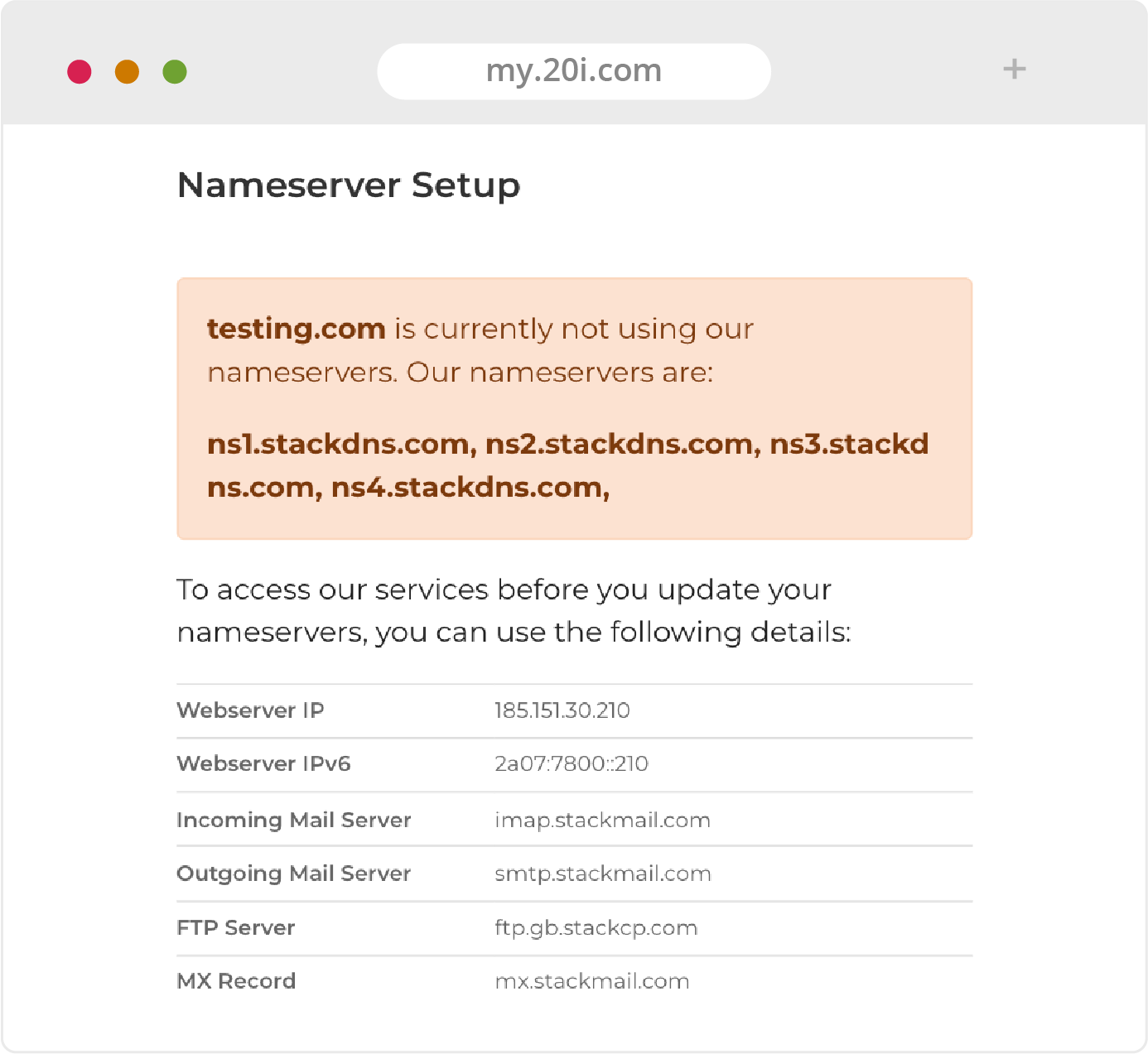
4. Create databases on 20i
Do this by navigating to My20i > Manage Hosting > [select package] > MySQL Databases. Note down the hostname, database name/username and password for your new database as you’ll need these details later. Repeat this step for each database you want to import.
5. Import your database backup to the newly-created database
Once again we recommend using phpMyAdmin for this purpose:
- My20i > Manage Hosting > [select package] > phpMyAdmin
- Automatically log in to phpMyAdmin for each of your databases. Click the ‘Import’ tab at
the top of your page - For each of your databases click ‘Sign in ‘ and navigate to the ‘Import’ tab at the top

- Browse your computer for the database export you have taken previously
- Select the format that matches the export: this will be SQL for most cases
- Click ‘Go’. If the import fails, you may wish to try again with ‘Enable foreign key checks’
unchecked
6. Update wp-config.php
Use the Code Editor feature of our File Manager and open the wp-config.php file. Update the credentials and save your changes.
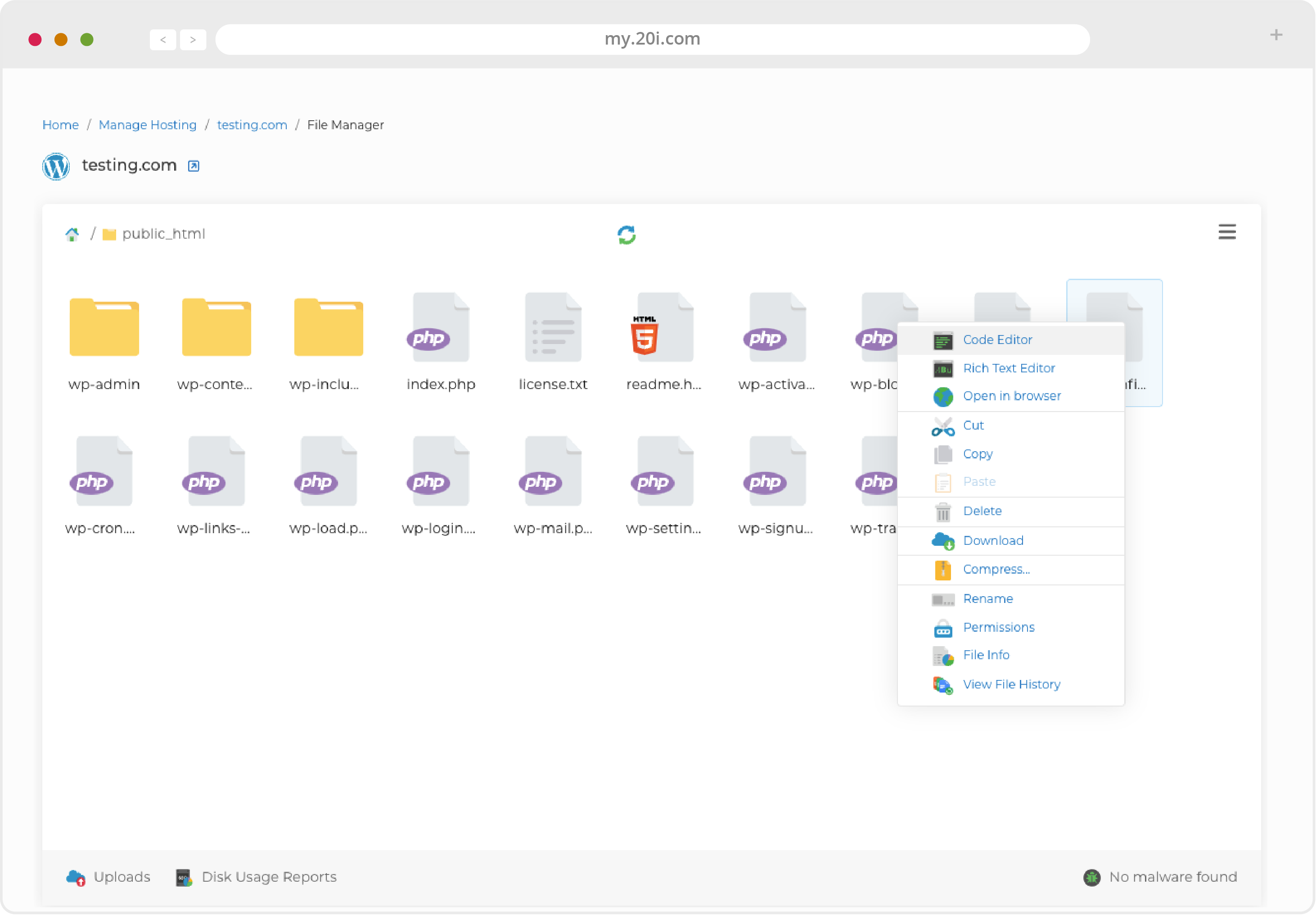
7. The website will now be fully functional on our platform
With your website migration completed; you are ready to learn about our powerful, purpose build control panel.
If something went wrong and you need any help with migration: our Support Team are available 24/7 to help.
>> Next Step: The My20i control panel
 Corey Seymour
Corey SeymourWordPress Hosting: The My20i control panel
From https://my.20i.com you can manage all aspects of your domains, hosting, and other services. You can also contact our support team directly here should you have any questions.
Account Management
Press your account name or thumbnail picture in the top right of My20i to manage:
- Account Overview
- Manage Renewals
- Security Details
- Active Sessions
- Contact Details
- Payment Methods
- Account Credit
- Invoices
- Account Preferences
- Email Notifications
- Team Members
- Refer a Friend
From the central My20i panels you have clear and easy access to:
Hosting Management
- Manage Hosting - Manage your web hosting options and settings
- Domains Names - Add, renew, manage and delete domain names
- VPS - Manage a Self-Managed Virtual Private Server
- WordPress Manager - Manage multiple WordPress sites from one dashboard
- Agency Hub - Manage your agency workflow
Migration Centre
- Migrations Overview - View and manage your pending and completed migrations
- Platform Transfer - Move websites to/from our WordPress, Linux, Windows or Managed Cloud Hosting platforms & view past platform transfers
- Domain Transfers - Check the status of all the domain transfers you have in progress
Sidebar Navigation
Desktop users can access the sidebar navigation menu to quickly and easily navigate all aspects of My20i. Mobile users have access to these options through the hamburger menu in the top right. Options include:
HOME
Use this to return to the main My20i control panel from wherever you are in the platform.
MANAGE SERVICES
Access your WordPress Manager, add Cloud Servers and control your Managed Cloud Hosting from this menu. Other aspects of your services can also be managed from this menu including:
- Manage Hosting
- WordPress Manager
- Manage Domains
- Search For New Domains
- Transfer Domains
- Deploy New Cloud Servers
- Order & Manage VPS
- SSL Certificates
AGENCY HUB
Manage projects, clients and invoicing from one intuitive dashboard.
REPORTS
Useful, detailed information on mailbox, bandwidth, disk and database usage - plus malware scanner reports.
MIGRATIONS
Begin a website migration from another provider (see Chapter 2), or carry out a Platform Transfer (for example, from Shared Hosting to Managed Cloud Hosting). This menu also covers domain transfers.
HELP & SUPPORT
Search our AI powered Support Database, read popular articles, contact our Support Team or share feedback with our platform development team.
Favourite and recent packages
When logged into your My20i dashboard, you’ll see an area called ‘Recent’ in the top right. This section populates with shortcuts to the Hosting Packages that you’ve managed most recently - enabling you to quickly pick up where you left off.
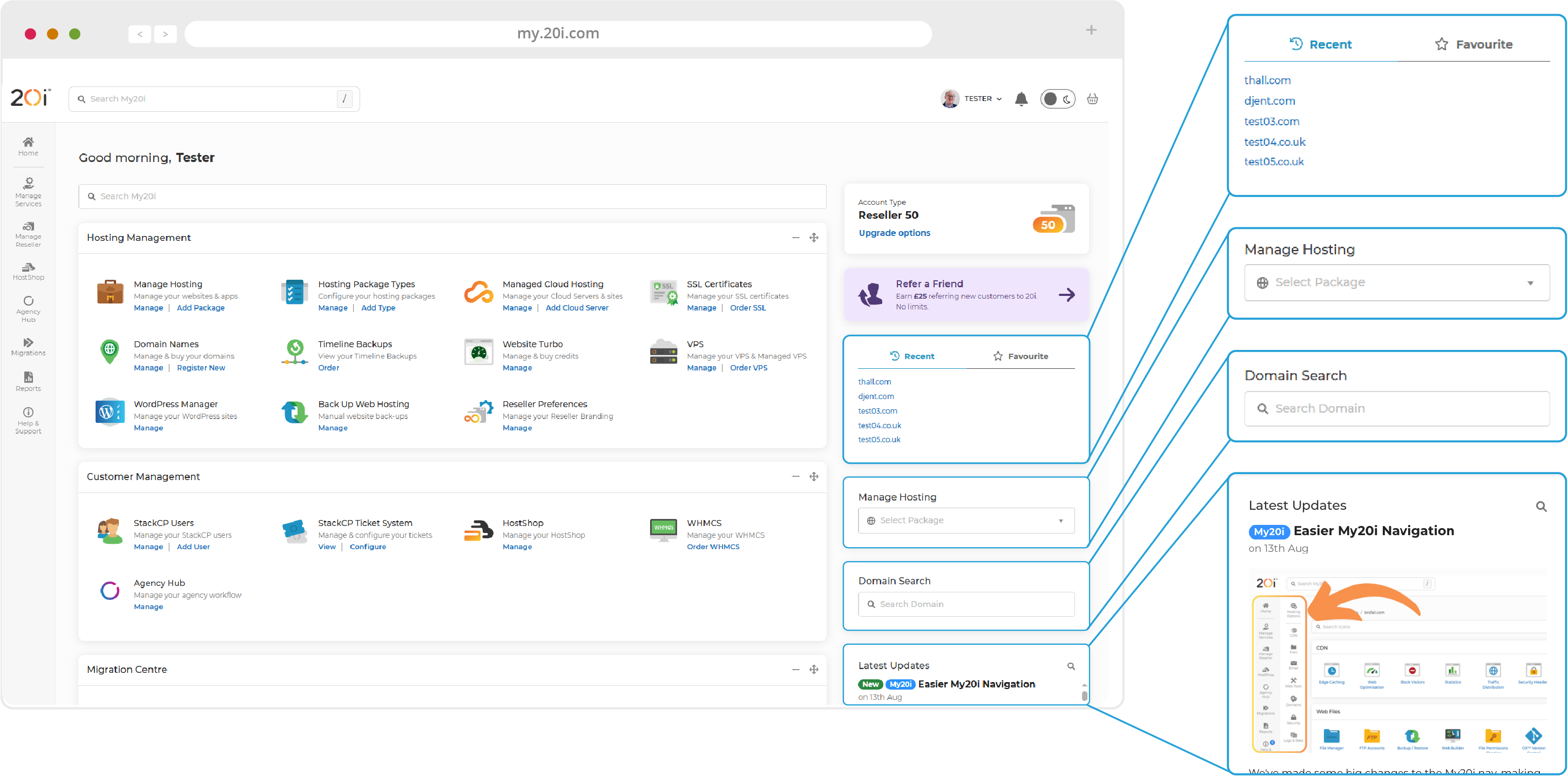
Next to ‘Recent’ there is a ‘Favourite’ tab. You can assign packages as favourites by clicking on them, and then checking the star in the top right.
Other Homepage Information
The My20i home page displays the 20i system status, and has a handy drop down menu to help you to find and manage packages.
You can also make use of the domain search tool and read up on the latest development updates from your dashboard.
>> Next Steps: Managing your Hosting
 Corey Seymour
Corey SeymourWordPress Hosting: Managing your Hosting
You can select and manage a Hosting Package through the menus and shortcuts on the My20i home screen.
Once selected, you will be taken to the packages’ service overview page, where you can manage all aspects of the package and website.
WordPress Tools
Our WordPress Tools suite offers a range of powerful tools to make it easier to manage WordPress sites.
Instead of having to log in to the WordPress dashboard for each site, you can manage themes, plugins and more from within My20i. It will only appear if you have WordPress-optimised Hosting.

Version Checker
When managing a WordPress hosting package; you’ll see the version your website is using at the top of the WordPress Tools section.
Version details are shown in green if you are fully up to date. If you’re running an older version, the version information will be orange. This is a handy way of checking if a website is up to date without having to log into /wp-admin and check manually.
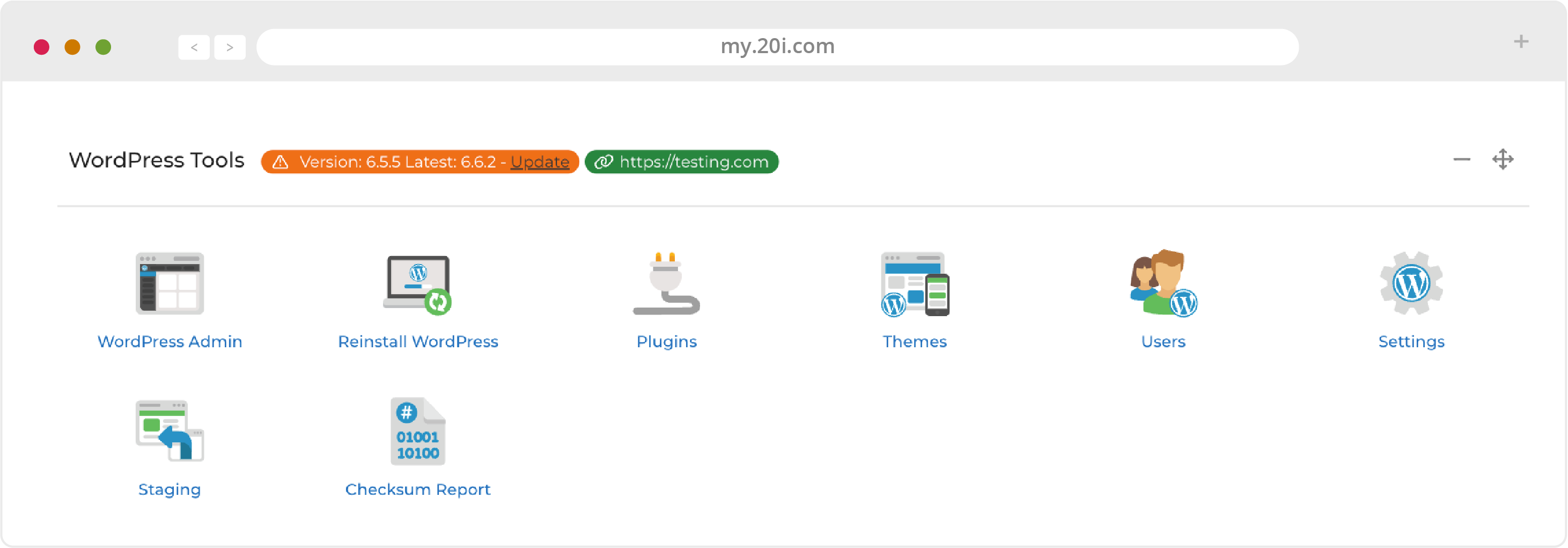
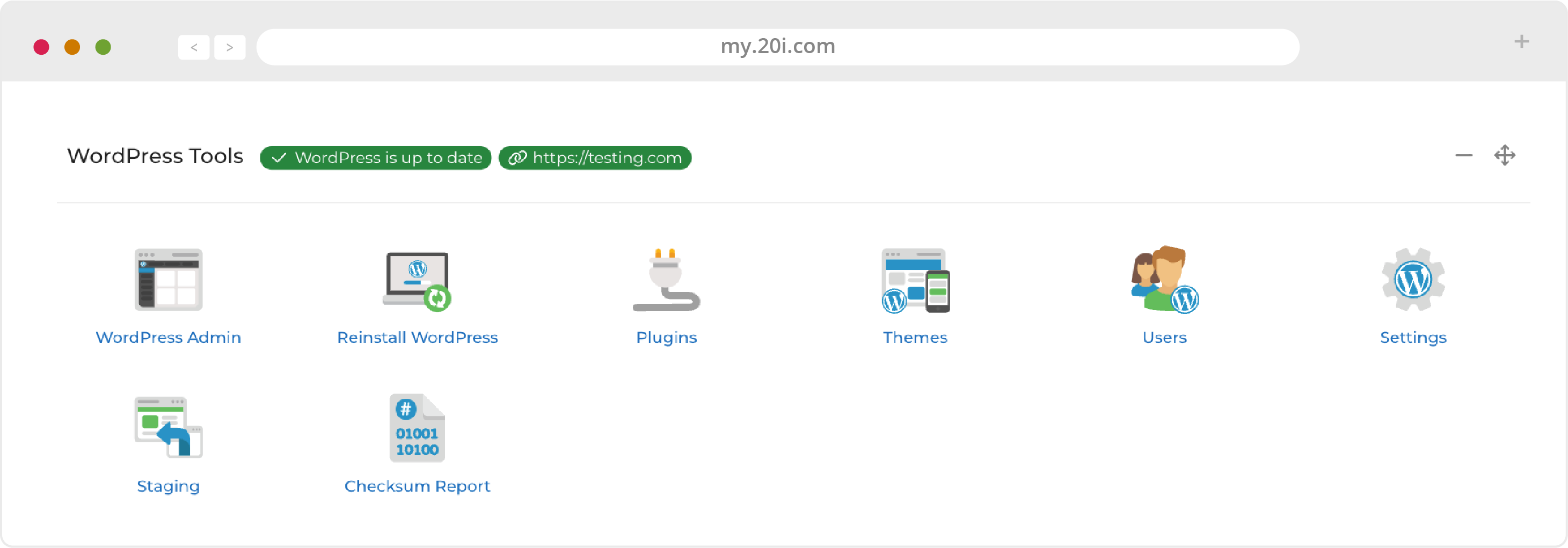
It’s important to keep WordPress updated for security reasons and to ensure there are no issues with the latest versions of any plugins you may be using. Always double check before updating to ensure compatibility.
- WordPress Admin - This is a simple link that takes you into WordPress. If you’re already logged-in to WordPress then you’ll be directed straight to the dashboard
- Reinstall WordPress - Sometimes, reinstalling a fresh copy of WordPress is the answer. With this feature it couldn't be easier or more straight forward
- Plugins - Manage all your WordPress plugins: you can activate/deactivate them and update them if necessary
- Themes - A full list of current themes that are installed, their versions and which are active. Similar to the Plugins area, you have the option to activate, deactivate or update themes
- Users - Lists all users along with their name, username and their role. You can add new users accounts from here too, assign custom roles
- Settings - Make changes to the site, home URL, site title and the site tagline
- Staging - A one-click WordPress staging environment for you to test changes and updates in a safe staging environment without impacting your live site. When happy with your changes; seamlessly migrate them over to your live site. We’ll show you how this is done in the next chapter
- Checksum Report - This checks the core files of the WordPress installation, and determines if they match those of the official WordPress core repository. If the files have been modified, then you’ll be notified. If the check fails and modified files are found, then a next step would be to check the on-demand malware scanner to ensure the installation has not been infected
Content Delivery Network (CDN)
- Edge Caching - Speed up your site for users wherever they are in the world. Control how your website
content is cached, and purge the cache if necessary - Website Optimisation - Improve the responsiveness of your website through these powerful enhancements
- Block Visitors - Block users for your site by country or IP address
- Statistics - See detailed CDN performance statistics - useful for debugging problems
- Traffic Distribution - View a map and stats of where the CDN traffic is coming from
- Security Headers - Manage Security Headers and control the how CDN can be accessed
Website Acceleration Suite
20i’s CDN powers-up your websites though our Website Acceleration Suite. This module can be configured to automatically improve website load times and performance by implementing best practices.
This includes optimising images, JavaScript minification and combining CSS - all to enhance speed and the Google PageSpeed Score. This in turn positively impacts search rankings and helps you develop high-performing websites at scale.
To apply these free performance enhancements; head to My20i and select the package that you’d like to speed up. From there, click on the Web Optimisation section where you’ll see the full list of the tweaks that can be toggled on or off.
We’d recommend using Web Optimisation and Staging together to ensure that your optimisations don’t conflict with any plugins.
If you are unsure where to start our Web Optimisation Wizard will guide you through the process.
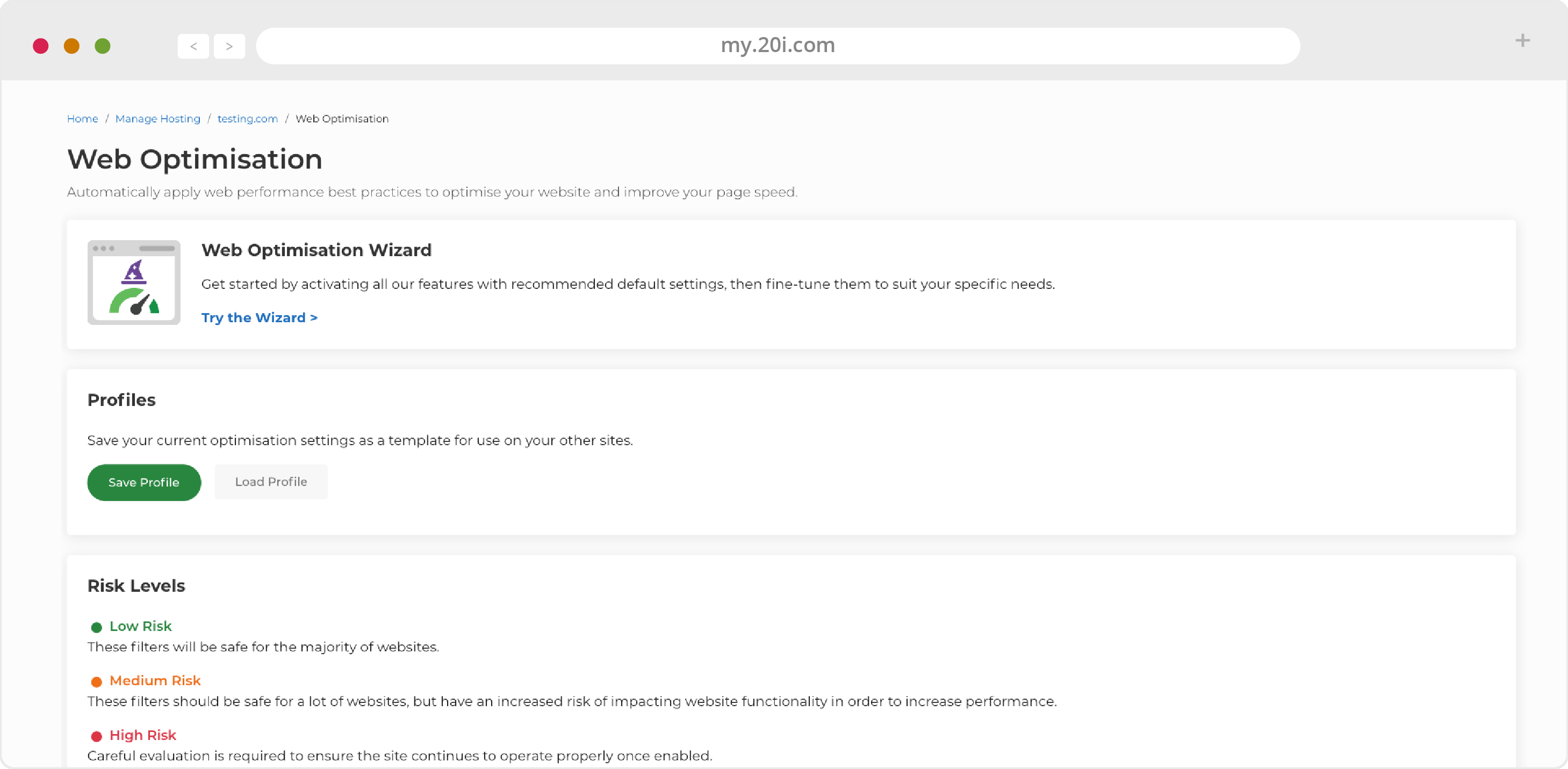
Web Files
- File Manager - Add, delete, open and edit website files and folders via a user-friendly web interface
- FTP Accounts - Manage access, permissions and users to allow easy collaborations, manual backups etc
- Backup/Restore - Creates and downloads website backups
- Timeline Backups - Access daily backups of your site - see Security and backups for more info
- File Permissions Checker - Websites can be hacked if they have the incorrect file permissions. This tool will check that you have the correct permissions and fix them if necessary
- Git Version Control - GitHub is used for collaborative web development, and My20i includes a graphical user interface
that helps simplify and speed up the process. Integrate your GitHub account and clone,
manage and create local and remote repositories
- Email Accounts - Create, manage and change passwords for your mailboxes
- Email Forwarders - Create rules to forward your email to a different email server
- Catch-All Forwarders - If someone sends an email to your domain, but gets the first part wrong, you can use this tool to make sure that it is forwarded on and simply blocked from getting through
- Autoresponders - Set up and edit automatic email messages in plain text or HTML. You can choose the dates they run for and whether or not to forward incoming email
- Send-only Addresses - Set up and edit email accounts that can only send emails, not receive them
- Receive-only Addresses - Set up and edit email accounts that can only receive emails, not send them
- Junk Mail Filters - Set rules and control the level of junk email filtering applied
- Webmail - Sign in to your online email service
- Email Summary - An overview of all email accounts, forwarders and autoresponders being used by this package
- Email Migration - The place to migrate your email from a previous provider
- Domainkeys (DKIM) - Improve the deliverability of your email by using a DKIM signature
- DMARC Wizard - Reduce spam and the risk of phishing by adding DMARC policies
Web Tools
- phpMyAdmin - This is used for PHP-based MySQL database management
- MySQL Databases - Manage databases and grant access other users
- Remote MySQL Access - Here you can allow others to access your database remotely by enabling specified IP addresses
- Change PHP Version - Change PHP version from default to the latest version to ensure optimal compatibility
- PHP Configuration - Change settings to suit the requirements of your applications
- Scheduled Tasks - Run tasks at specific times and intervals
- Redirects - Create temporary or permanent redirects from My20i
- Sitemap Generator - Create an XML sitemap of your site to help search engines and other bots
- Custom Errors - Manage what happens for your different error types on your site
- Auto Diagnostics - Check for any common misconfiguration issues or errors involving malware, error logs, file permissions or SSL certificates
- Maintenance Mode - Put your site into ‘Maintenance mode’ where a message will appear indicating that the website is undergoing maintenance
Domain Names
- Domains - Add or remove domain names on your hosting package
- Subdomains - Add and manage subdomains in the format: subdomain.yourdomain.com
- Manage DNS - Add, edit and reset DNS records
- Domain Contacts - Manage the contact details of the people associated with a domain
- WHOIS - View the WHOIS Result for the associated domain
- Nameservers - Edit and change the nameservers of a domain
- Domain Privacy - Manage all aspects of your domain privacy from this dashboard
- DNSSEC Protection - Activate or deactivate protection against forged DNS answers when using our nameservers
- Transfer Away - Lock, unlock and easily transfer your domains to another provider
Security
- SSH Access - Add and manage public keys for SSH
- Hotlink Protection - Prevent websites direct linking your website resources (e.g. images and video) and consuming bandwidth
- SSL/TLS - Ensure all your visitors access your website via an encrypted connection
- Password Protection - Create password protected directories for your website
- Directory Indexing - Turn directory indexing on or off for your website
- Malware Scan - Scan your site’s files for malware. While we scan your site every day automatically, you can start a manual scan here
Logs & Stats
- Access/Error Logs - View access logs and errors, and download full logs for analysis
- Bandwidth Usage - Bandwidth and hot statistics taken directly from our load balancers
- Mail Logs - Monitor email deliverability, troubleshoot and track important notifications for audit trails and legal compliance
>> Next Step: WordPress Staging
 Corey Seymour
Corey SeymourWordPress Hosting: WordPress Staging
20i WordPress Hosting includes a Staging tool that allows you to test new features in a safe, private environment without impacting your live site.
Staging is a part of the WordPress Tools suite, and is accessible when you manage an individual hosting package. Watch our video tutorial for more on how to set up WordPress Staging.
Creating the Staging Site
To begin the staging process, select the Staging icon:

From the WordPress Staging screen; use the ‘Select Clone Type’ dropdown menu to choose between the two options.
1 - Install Default WordPress
Puts a fresh copy of WordPress onto the staging environment, allowing you to start building from scratch
2 - Clone live into Staging
Makes a duplicate of your live site and puts it into the staging environment. Your live site will keep serving your users, leaving you free to continue development and testing on the staged version.
Once the process is complete, you can access your staging site by clicking the Visit Staging button.

Editing the Staging Site
With your WordPress site successfully staged - everything is ready for you to continue developing and testing your website.
You can edit the staging site through WordPress Admin, File Manager or FTP.
If you are using File Manager or FTP then you’ll see a newly created staging_html directory where the cloned files are stored. These are files that you’ll need to work on to make the changes to your staged website.
To make changes to the database; head to MySQL Databases. You’ll see a newly created SCSTAGING database which you can login to via phpMyAdmin. The site and home URL for the WordPress site will be prefixed with the .staging subdomain.
Cloning the Staging Site to Live
On the WordPress Staging page: tick the checkbox that says ‘I can confirm this will overwrite my existing, live website data’.
Then press the ‘Clone into Live’ button. Depending on the size and complexity of your website; this may take a few minutes to complete.
Once completed, any changes you’ve made to the staging site will have been replicated onto the live version of your site
>> Next Step: Security and Backups
 Corey Seymour
Corey SeymourWordPress Hosting: Security and backups
While your hosting includes security measures like a web application firewall, malware scanning and brute force login protection, we’d recommend that you still follow security best practices:
- Use strong passwords that you don’t use anywhere else
- Use Two Factor Authentication (2FA) - the two-step verification process that provides an extra layer of security for you when accessing your account
- Only access your website and accounts over secured internet connections
- Only create sub user accounts for people you know and trust
SSL
For better security, improved search engine rankings, and helping your visitors’ peace of mind; you can add an SSL security certificate to your website.
This will ensure that you, your visitors and your users can browse your site securely and confidently.
Backups
We back up your website files and database daily, so if there’s ever any problems, you can use our Timeline Backups service to restore it. In a few clicks you can restore back to a previous snapshot. All backups are hosted on a different server to your website for extra protection.
You can never have too many backups, so as best practice we’d advise you to take a manual backup of your site too - especially before making major changes. If you’d like to create a manual backup of your content, you can download all your files via FTP or use the Backup/Restore option in My20i.
Timeline Backups Pro
Similar to our standard Timeline Backups; Timeline Backups Pro also stores your website files for 30 days, but further increases database snapshots to 60 days and, most importantly; also backs up all of your email across all email accounts.
The Pro tier of backups was added in response to customer feedback to provide extra contingency in the event of a loss of email services and greater peace of mind for our users.
Upgrade Timeline Backups Pro by heading to My20i and selecting the package you wish to add the service to. Click on ‘Timeline Backups’ and the ‘Upgrade Timeline Backups’ button.
>> Next Step: Further help.
 Corey Seymour
Corey SeymourWordPress Hosting: Further Help and Next steps
The WordPress community has a wealth of valuable tools and services available for free, including:
- A complete codex: https://codex.wordpress.org
- A comprehensive official theme directory: https://wordpress.org/themes
- An extensive plugin directory: https://wordpress.org/plugins
- A highly active support community: https://wordpress.org/support/forums
You can search our detailed Knowledge Base here: https://docs.20i.com
Many of the support articles you'll find in our Knowledge Base are supported by step-by-step videos that can also be browsed on our YouTube channel: https://www.youtube.com/@20ihosting
You can also get valuable business tips and read articles and reviews on ‘everything internet’ at https://www.20i.com/blog
If you have any questions or issues at all, please raise a ticket or chat with our in-house support staff via My20i and one of our helpful team members will get back to you.
 Corey Seymour
Corey Seymour